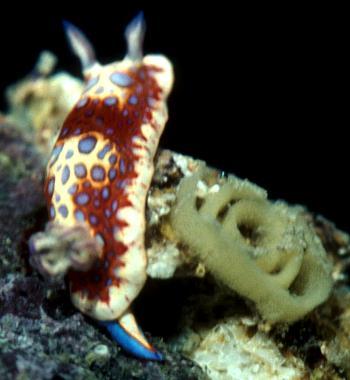
Chromodoris clenchi
(Russell, 1935)
Order: NUDIBRANCHIA
Suborder: DORIDINA
Superfamily: EUDORIDOIDEA
Family: Chromodorididae
DISTRIBUTION
Caribbean
PHOTO
Havana, Cuba. Photo: Angel Valdes.
"Both C. clenchi and C. binza have in common an hourglass yellow pattern on the dorsum, which is absent in C. neona. However, C. clenchi has well-defined, rounded and violet dorsal spots, surrounded by thin red lines, whereas C. binza has a much more irregular pattern with a red network of lines surrounding irregular pale blue areas". [From Angel Valdes's message distinguishing these three species].
See Angel Valdes' other message discussing this species and the similarly coloured C. binza, C. britoi and C. neona.
Reference:
• Ortea, J., Valdés, A. & Espinosa, J. (1994) North Atlantic nudibranchs of the Chromodoris clenchi colour group (Opisthobranchia: Chromododorididae). Journal of Molluscan Studies, 60: 237-248.
Rudman, W.B., 2000 (October 10) Chromodoris clenchi (Russell, 1935). [In] Sea Slug Forum. Australian Museum, Sydney. Available from http://www.seaslugforum.net/find/chroclen
Related messages
Chromodoris clenchi from St Martin, Caribbean
April 12, 2010
From: Aurélien Roger


I found this Doris on a reef, between Anguilla and St Martin, North Caribbean.
It was on an old piece of motor engine, full of sponges.
Size : around 1 cm.
Deep : 14 m / 42 feet deep
Date : 7 april 2010
"running away" from underwater light.
Locality: reef between Anguilla (UK Virgin island) & St Martin, 14 metres, Carribean Sea, 07 april 2010, 40 meters visibility, 27C degrees underwater. Length: 1 cm. Photographer: Aurélien Roger.
Aurélien Roger
aurelroger@aol.com
Aure, 2010 (Apr 12) Chromodoris clenchi from St Martin, Caribbean. [Message in] Sea Slug Forum. Australian Museum, Sydney. Available from http://www.seaslugforum.net/find/23470
Dear Aure,
This brightly coloured nudibranch is Chromodoris clenchi. If you look at the species' Fact Sheet, and attached messages, you will see there are a number of similarly coloured species.
Best wishes,
Bill Rudman
Chromodoris clenchi feeding
September 28, 2007
From: Anne DuPont
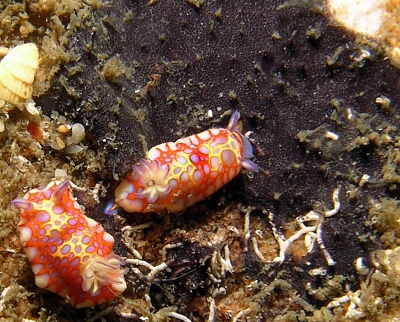
Concerning message #20272:
Hello Bill,
More chromodorid feeding photos for you. I observed these two Chromodoris clenchi "munching away" on this purple sponge. When they moved away, you can see the area where they had eaten the sponge.
Locality: West Palm Beach, 15 feet, Florida USA, Atlantic Ocean, August 16, 2007. Length: Appx 8 mm each. Photographer: Anne DuPont.
Thanks again for the Forum.
Cordially,
Anne DuPont
Delray Beach, Florida, USA
akdupont@bellsouth.net
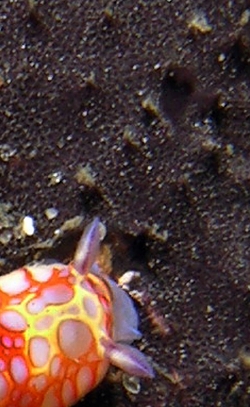
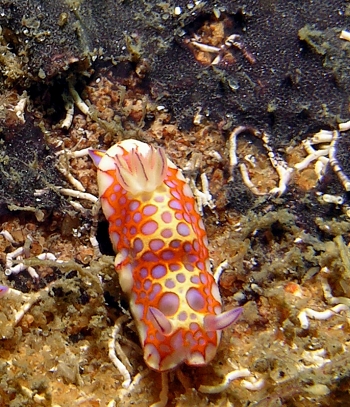

Dear Anne,
Thanks for this valuable observation - which I think is the first feeding record for this species. My guess is that this sponge is as a species of Chelonaplysilla - a Caribbean counterpart to the Indo-West Pacific C. violacea, perhaps. Species of Chelonaplysilla are unique within the Darwinellidae in having sand grains incorporated in their skeleton, which gives them a rough sand-papery feel.
Best wishes,
Bill Rudman
Chromodoris binza & C. clenchi from Florida
February 14, 2002
From: Linda Ianniello
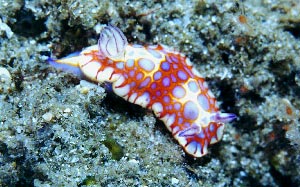
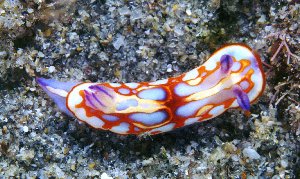
Hi Bill,
I noticed on your page for Chromodoris binza you have shots of it and Chromodoris clenchi to show the differences. Here are shots of each of them from Florida, again showing the differences between the two. We found C. clenchi [UPPER PHOTO] in the Lake Worth Lagoon, in an area that is very tidal, in about 15'. We have seen it both during the day and night dives. C. binza [LOWER PHOTO] has been found off Deerfield Beach, again in about 15'. Both are very small, just over 1/2 inch. Both these were found January, 2002, but have been seen occasionally over the last 6 months. Thank you for the great job you are doing with the Sea Slug Forum. I am enjoying it tremendously and learning a lot about the slugs we are starting to find in Florida.
Linda
lindai@us.ibm.com
Ianniello, L., 2002 (Feb 14) Chromodoris binza & C. clenchi from Florida. [Message in] Sea Slug Forum. Australian Museum, Sydney. Available from http://www.seaslugforum.net/find/6209Dear Linda,
Thanks for these photos. They are colourful animals. I must say that after reading the scientific discussion on why these two 'species' are distinct, I still have my doubts. I can't see anything in the colour pattern, reproductive system or radular morphology which really shouts out "I'm different!" Usually when there are two species with very similar colour patterns we have been lucky enough to find at last one anatomical difference to 'prove' they are different. In this case it doesn't seem to be so easy.
This is the type of problem that can often be resolved by resident naturalists, like yourself, who visit the same places regularly and can keep an eye out for them. It would be good to know if they feed on the same or different sponges, or if their egg ribbons are different. If they are the same species, perhaps you can find them together mating? It may take a couple of years to get lucky and find them on their sponge food, or laying eggs, or mating, but when you do I would love to see a photo or two.
Best wishes,
Bill Rudman
Juvenile Chromodoris clenchi from Jamaica
June 19, 2001
From: Barry Lipman
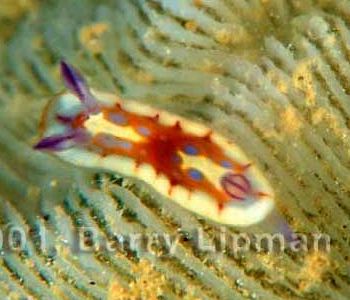
Hi, you've been very helpfull in the past. Here's another unidentified Nudibranch for you to post:
http://www.barrylipman.com/JPEGS/UFOs/UFO%27s07.htm
It is a bit less than 5mm long, yet quite elaborate for its small size. I photographed it in Discovery Bay, Jamaica, a couple of weeks ago.
Thanks,
Barry Lipman
http://www.barrylipman.com
b_lipman@hotmail.com
Lipman, B., 2001 (Jun 19) Juvenile Chromodoris clenchi from Jamaica. [Message in] Sea Slug Forum. Australian Museum, Sydney. Available from http://www.seaslugforum.net/find/4615Dear Barry,
This is a juvenile chromodorid. I suspect it is Chromodoris clenchi but as you will see from the comments at the top of this page there are a few very similarly coloured species. I suspect until we know more about this species, identifying juveniles will be a slighty risky exercise.
For those of you interested in beautiful underwater photos Barry's site [http://www.barrylipman.com] is well worth a visit.
Best wishes,
Bill Rudman
Photos of Chromodoris clenchi
October 14, 2000
From: Dave Behrens
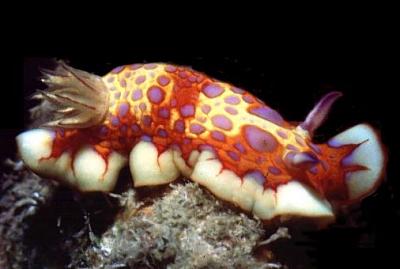
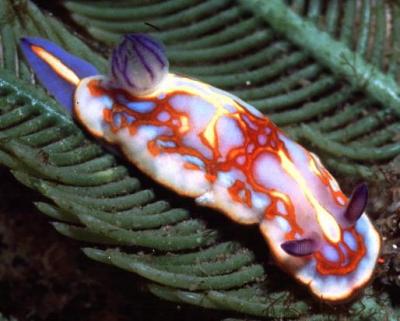
Dear Bill:
Well I felt so guilty that I didn't have a good scan of either of the yellow California dorids to send you, the least I can do is submit a couple fantastic photos of Chromodoris clenchi to add to the recent discussions on the closely related group of chromodorids. Both photos were taken in the
Caribbean, by Jeff Hamann, of El Cajon, California. An amazingly beautiful species.
Dave Behrens
Dave@seachallengers.com
Behrens, D., 2000 (Oct 14) Photos of Chromodoris clenchi. [Message in] Sea Slug Forum. Australian Museum, Sydney. Available from http://www.seaslugforum.net/find/3168Note: See Angel Valdes's message identifying the second of Jeff's photos as C. binza [added Oct 15, 2000].
Thanks Dave & Jeff,
Any idea of their size and where they were found? It is indeed a beautiful animal and looking at C. binza, C. neona, I can see why there is considerable confusion in the literature over their identity. Phanor, if you are looking for a project, it would be very interesting to see whether you could keep some of these animals alive and record (and photograph) their colour pattern as they grow to see whether it changes as they grow and just how much colour variation there is within a single population.
Best wishes,
Bill Rudman.
